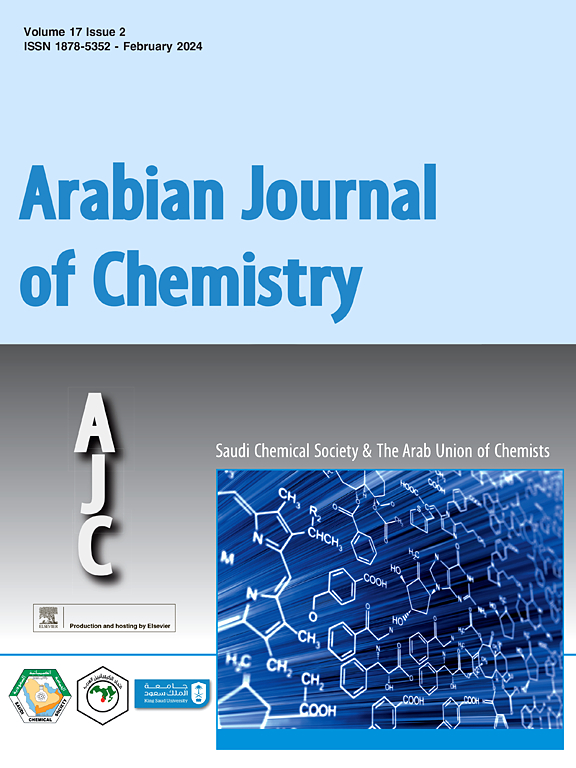白芷多糖的超声波辅助 DES 提取优化、表征、抗氧化和硅学研究
IF 5.2
2区 化学
Q2 CHEMISTRY, MULTIDISCIPLINARY
引用次数: 0
摘要
本研究采用超声辅助深共晶溶剂萃取法(DES)提取了白芷中的多糖。结果表明,由氯化胆碱(HBA,氢键受体)和1,4-丁二醇(HBD,氢键供体)组成的摩尔比为1:3的DES是提取多糖的最佳体系。采用三因素三水平的箱-贝肯设计(Box-Behnken design)对超声波功率、萃取时间和温度进行了优化,以提高多糖的产量。最佳提取参数确定如下:在这些条件下,提取率几乎与响应面模型的理论预测值一致,是传统热水提取法的 1.33 倍,且所需时间更短。采用 DPPH、ABTS 和羟基法对多糖的抗氧化性进行了评估,结果表明超声辅助 DES 提取的 ADRP 具有优异的抗氧化能力,并且与药物浓度呈剂量反应关系。结构分析表明,ADR 多糖是一种富含醛酸糖(即岩藻糖、鼠李糖、阿拉伯糖、半乳糖和葡萄糖)的杂多糖,其摩尔比为 0.47:1.99:17.61:64.76:15.17。多糖的数均分子量为 97.422 kDa,重均分子量为 245.678 kDa。网络药理学和分子对接分析表明,单糖Rha和Ara可能分别与蛋白质GSR和GSTA1发生相互作用,表明ADRP具有良好的抗氧化潜力,可应用于多个领域,未来发展前景广阔。本文章由计算机程序翻译,如有差异,请以英文原文为准。
Ultrasonic-assisted DES extraction optimization, characterization, antioxidant and in silico study of polysaccharides from Angelica dahurica Radix
In this study, polysaccharides from Angelica dahurica Radix (ADR) were extracted by using ultrasonic-assisted deep eutectic solvent (DES) extraction method. The DES consist of choline chloride (HBA, hydrogen bonding acceptor) and 1, 4-butanediol (HBD, hydrogen bonding donor) with the molar ratio of 1:3 was proved as the best system for polysaccharides extraction. A Box-Behnken design with three factors and three levels was utilized to optimize ultrasonic power, extraction time and temperature for increased polysaccharides yield. The optimal extraction parameters were determined as follows: DES water content of 20 %, liquid–solid ratio of 10:1 mL/g, ultrasonic time of 21 min, temperature at 60 °C, and ultrasonic power of 435 W. These conditions yielded an extraction rate nearly matching the theoretical predicted value of the response surface model, surpassing the traditional hot water extraction method by 1.33 times and requiring less time. The antioxidant polysaccharides was assessed using DPPH, ABTS and Hydroxyl methods, which indicated that ADRP extracted by ultrasound assisted DES had excellent antioxidant capacity and showed a dose–response relationship with drug concentration. Structural analysis identified ADR polysaccharides as a heteropolysaccharide rich in sugar aldonic acids—namely, fucose, rhamnose, arabinose, galactose and glucose—with molar ratios of 0.47:1.99:17.61:64.76:15.17. The polysaccharides’ number-average molecular weight was determined to be 97.422 kDa, with a weight-average molecular weight of 245.678 kDa. Network pharmacology and molecular docking analysis suggest that the monosaccharides Rha and Ara could potentially interact with the proteins GSR and GSTA1, respectively, indicating that ADRP had good antioxidant potential and could be applied in multiple fields with promising development prospects in the future.
求助全文
通过发布文献求助,成功后即可免费获取论文全文。
去求助
来源期刊

Arabian Journal of Chemistry
CHEMISTRY, MULTIDISCIPLINARY-
CiteScore
10.80
自引率
3.30%
发文量
763
审稿时长
63 days
期刊介绍:
The Arabian Journal of Chemistry is an English language, peer-reviewed scholarly publication in the area of chemistry. The Arabian Journal of Chemistry publishes original papers, reviews and short reports on, but not limited to: inorganic, physical, organic, analytical and biochemistry.
The Arabian Journal of Chemistry is issued by the Arab Union of Chemists and is published by King Saud University together with the Saudi Chemical Society in collaboration with Elsevier and is edited by an international group of eminent researchers.
 求助内容:
求助内容: 应助结果提醒方式:
应助结果提醒方式:


